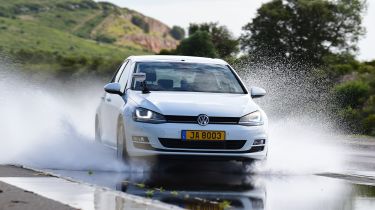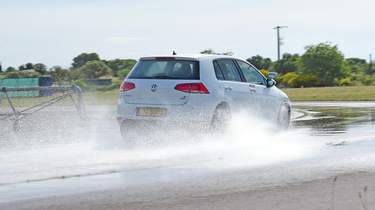Best car tyres to buy now 2024: top tyres tested and reviewed
We reveal the best tyres you can buy for your car
We return to one of the UK’s biggest-selling tyre sizes for our 2024 summer tyre test: 225/45 R17. It’s three years since we put this size through the comprehensive Auto Express test mill, and as you’d expect of such a high-volume sector, some brands have launched replacements for tyres that competed last time. These include Michelin, Goodyear, Continental and Bridgestone, while Pirelli, Vredestein and reigning champion Hankook return with ostensibly the same tyres, and Falken joins the fray.
As ever, our long-established and exhaustive test delivers all the data you need to help you make an informed choice when replacing your car’s tyres. This year we’ve increased the scope of the test; in addition to recording cabin noise levels, we have made a subjective assessment of refinement – road noise and ride comfort – driving all the tyres over the same mix of surfaces.
This year’s venue was the Goodyear proving ground near Montpellier in the south of France.
What we tested
To circumvent problems with supply and stock in the UK, we sourced all eight tyres from the open market via an independent wholesale supplier in Germany. Each maker nominated the tyre for us to test, the majority opting for a speed rating of Y (up to 186mph), and the rest W (168mph), with weight ratings from 90 to 94.
Used - available now

2022 Fiat
500e
27,167 milesAutomaticElectric
Cash £10,249
2021 Cupra
Formentor
34,791 milesAutomaticPetrol2.0L
Cash £27,049
2023 Hyundai
Kona Hybrid
15,029 milesAutomaticPetrol1.6L
Cash £16,775
2023 Nissan
Juke
20,197 milesAutomaticPetrol1.0L
Cash £15,490EU label ratings are included for fuel economy (RR – rolling resistance) and wet grip (WG). These range from A to E, with A best. We also give pass-by noise (N), which is measured in decibels, so the lower the number the better.
| Tyre | Ratings |
| Bridgestone Potenza Sport | 94Y RR: D WG: A N: B (72) |
| Continental PremiumContact 7 | 91Y RR: C WG: A N: B (71) |
| Falken Ziex ZE310 Ecorun | 94W RR: D WG: A N: A (69) |
| Goodyear Eagle F1 Asymmetric 6 | 91Y RR: C WG: A N: B (69) |
| Hankook Ventus S1 evo3 | 94Y RR: C WG: A N: B (72) |
| Michelin Pilot Sport 5 | 94Y RR: C WG: A N: B (72) |
| Pirelli Cinturato P7 (P7C2) | 94Y RR: C WG: A N: B (70) |
| Vredestein Ultrac | 94Y RR: C WG: A N: B (69) |
How we tested
Wet
Performance in wet conditions is the most significant part of our program, because that’s where drivers are most likely to exceed the abilities of their tyres or themselves. We measured each tyre’s ability in braking and cornering, as well as its resistance to aquaplaning in deeper water.
Braking was conducted on a consistently wetted surface from 50mph down to 1mph; the stopping distance was calculated from the average of a number of runs, while cornering was derived from lap times on a 35m circle covered with 1mm of water. The wet handling circuit, a fraction over one mile long and wetted to 8mm, brought these elements together, along with transient response, dynamic balance and traction, to reveal overall ability.
For straight-line aquaplaning, we measured the speed at which each tyre was slipping 15 per cent more in 7mm of water compared with the one in the dry. To see how the tyres resisted aquaplaning while cornering, they were run on a curve flooded to 8mm at speeds from 30 to 56mph and the average residual lateral acceleration was calculated.
Dry
Braking distances were measured from 62mph (100kmh) down to 1mph, and we used Goodyear’s recently resurfaced, two-mile dry handling circuit, with its mix of fast and slow turns, to establish lap times and to assess handling balance, grip and traction on dry asphalt.
Noise
The EU tyre labels describe drive-by noise (how loud a tyre is from the outside), whereas we assess noise in the cabin – what the driver hears. In addition to measuring coast-down noise on smooth and coarse surfaces, this year we added a subjective element, assessing each tyre’s refinement in terms of noise and bump absorption over a variety of surfaces. All three elements contribute to the ‘noise and refinement’ score.
Fuel economy
Rolling resistance dictates fuel economy and is a measure of the force required to roll a tyre. Our figures, attained through standard industry procedures, are more accurate than the EU tyre label because those ratings – from A (good) to E (poor) – are bands and represent a range. A four per cent change in rolling resistance is broadly equivalent to a one per cent movement in fuel consumption.
Prices
These are sourced from our online retailer test winner, Black Circles, and are for a fitted tyre at the time of writing. Price has a limited impact on the overall result because tyres are a safety-critical item.
Calculating a winner
The results for each category are converted into percentages. Half of the overall score is allocated to wet performance, and 40 per cent to dry, with the emphasis on braking and handling in both instances.
The remaining 10 per cent is accounted for by the other tests. The top-performing tyre in each test is scored at 100 per cent, with the others rated relative to this.










